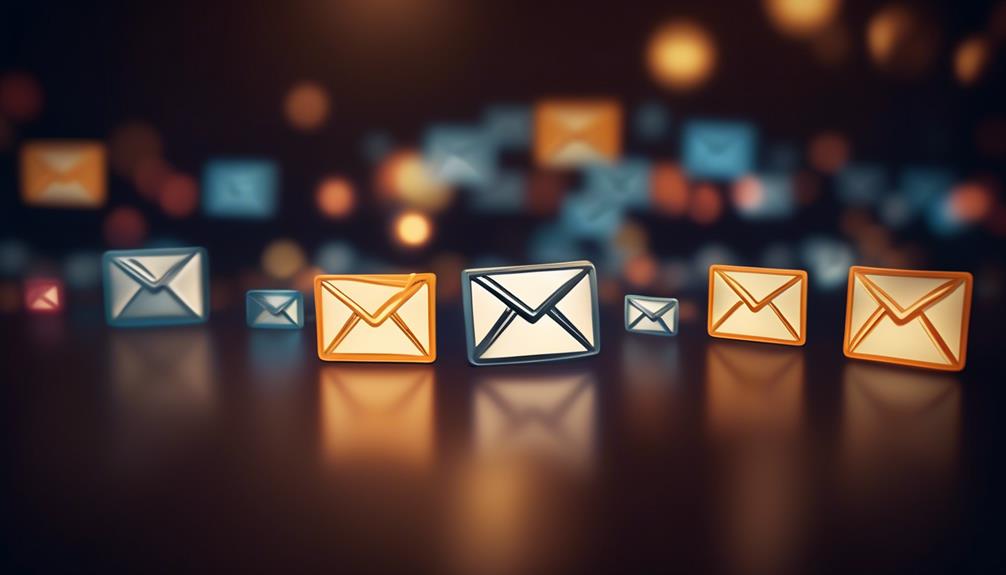We’re all familiar with the idea that effective sales email campaigns blend both art and science, but what really makes them work?
It's not just about crafting compelling content; it's about understanding your audience and engaging them in a way that feels personalized and valuable.
So, how do we strike that balance and ensure our sales email sequences hit the mark?
Well, let's explore the key elements and strategies that contribute to creating successful sequences, and how they can ultimately drive results for your business.
Key Takeaways
- Tailoring email sequences to buyer personas enhances relevance and effectiveness.
- Incorporating social proof increases trust and credibility.
- Clear call-to-action motivates prospects to move forward.
- Utilizing automation software streamlines the process and provides insights.
Email Sequence Types
When crafting successful sales email sequences, it's essential to understand the various types of email sequences that can be employed to engage and convert leads. Understanding these types can help us create effective and targeted sequences that provide value to our leads.
The first type is the Nurturing Email Sequence, which aims to build a relationship with leads by providing free, valuable content. This helps in establishing trust and positioning our brand as a helpful resource.
The Engagement Email Sequence, on the other hand, focuses on encouraging interaction and response from leads. These emails often include questions or surveys to prompt engagement.
The Conversion Email Sequence plays a crucial role in moving leads further down the sales funnel by highlighting the value of our offerings and encouraging them to make a purchase.
Follow-Up Email Sequences are essential for maintaining contact with leads who've shown interest but not yet converted.
Lastly, Reminder Email Sequences can help in re-engaging leads who may have gone inactive.
Understanding and utilizing these types of email sequences can significantly help in converting leads into customers.
Key Elements of Compelling Sequences

As we shift our focus to the key elements of compelling sequences, it's crucial to understand how these elements contribute to the effectiveness of the various types of email sequences discussed. Crafting successful sales email sequences requires attention to certain key elements that drive engagement and conversions.
Here's what goes into creating compelling sequences:
- Tailoring to Buyer Personas: Understanding your audience's pain points, preferences, and behaviors is crucial. Customizing sequences to resonate with specific buyer personas and their needs enhances relevance and effectiveness.
- Optimizing Sales Cycle Length: Determining the ideal sequence length, number, and frequency of touches is essential. This ensures that your email sequence aligns with the typical length of your sales cycle, maximizing engagement without overwhelming prospects.
- Value-Driven Content: Varying the value proposition and information delivered in each touch is vital. Providing relevant and valuable content, incorporating social proof, and including a clear call to action in each email ensures that your sequence keeps prospects engaged and motivated to move forward.
Effective Cold Email Strategies
Crafting effective cold email strategies is essential for engaging prospects and driving conversions. When creating a cold email sequence, it's crucial to focus on personalization, clear call-to-actions, and segmentation.
Personalizing emails based on the recipient's interests and previous interactions increases relevance and engagement. Including a clear call-to-action in each email guides subscribers on the next steps, leading to higher conversion rates. Segmenting the audience based on behavior and preferences allows for targeted and tailored content, enhancing the overall effectiveness of the cold email sequence.
To write effective cold email sequences, it's essential to test and optimize based on data and feedback. Using email automation software can streamline this process and provide valuable insights. Planning the sequences in advance and creating a schedule ensures consistency and timely delivery. Additionally, studying case studies and best practices for email sequence examples can offer valuable insights and inspiration.
When sending cold emails, the subject line plays a crucial role in capturing the recipient's attention. Crafting compelling subject lines that are concise and relevant increases the open rates. Leveraging abandoned cart emails as part of the cold email sequence can also re-engage potential customers and drive conversions.
Building Successful Email Sequences

After mastering effective cold email strategies, we now shift our focus to building successful email sequences by defining our situation, goals, and buyer persona to tailor the sequence effectively.
To build successful email sequences, we must first define our situation, goals, and buyer persona. Understanding these elements allows us to create a tailored sequence that resonates with the recipients and compels them to take action.
Next, it's crucial to determine the right length, number, and frequency of touches based on our sales cycle. This ensures that we're not overwhelming the recipients with too many emails or leaving them disengaged with too few.
Lastly, personalization is key. Each touch within the sequence should be personalized with a unique value proposition and information that's relevant to the recipient. This approach makes the emails more engaging and increases the likelihood of prompting the prospect to take action.
How Can Automation Improve the Effectiveness of Sales Email Sequences?
Automation is the key to streamline and improve the effectiveness of sales email sequences. By using technology to automate sales email sequences, businesses can ensure timely follow-ups, personalized content, and accurate analytics tracking. This can lead to higher engagement and conversion rates, ultimately driving more sales.
Best Practices for Email Sequences
To maximize the effectiveness of email sequences, it's essential to adhere to best practices that enhance engagement and drive conversions.
When crafting email sequences, it's crucial to utilize automated emails for timely and personalized communication. Sales reps should leverage nurture emails to establish rapport and provide value to prospects based on their buyer persona.
Utilizing well-crafted email templates ensures consistency in messaging and branding across sequences. Including a clear and compelling Call to Action (CTA) in each email is vital for guiding prospects towards the desired conversion action.
Additionally, incorporating a Conversion Email that focuses on closing the sale or securing a prospect booking can significantly impact the sequence's success. It's essential to consider the timing and frequency of emails to avoid overwhelming recipients, making a Reminder Email a valuable addition to gently prompt action.
Frequently Asked Questions
How Do You Create an Effective Email Sequence?
We create effective email sequences by tailoring them to our specific goals and buyer persona. Our sequences provide value at each touchpoint, using varied value propositions and personalized messages across different communication channels.
We hook recipients with compelling subject lines and offer upfront value, while determining the right length, number, and frequency of touches for our sales cycle.
This approach ensures our email sequences are impactful and drive results.
How Do You Create a Good Sales Sequence?
To create a good sales sequence, we focus on defining the situation, goals, and buyer persona. We tailor the value proposition and information for each touch to keep it engaging.
Personalizing communications based on industry, role, and challenges makes it more relevant. We mix up the type of touches and go multi-channel for better engagement.
Providing value upfront before asking for their time keeps the language natural and recipient-focused.
What Is the Email Sequence Structure?
When structuring an email sequence, we ensure it effectively guides recipients towards our goals. It typically starts with a warm welcome email, followed by onboarding completion, lead nurturing, re-engagement, and event emails.
We strategically plan the subscribers' journey, automate the process for efficiency, and track email performance. This structured approach helps us engage and convert leads, fostering successful sales outcomes.
How Many Emails Should Be in a Sales Sequence?
We find that the optimal number of emails in a sales sequence varies based on the specific sales cycle and target audience. Our approach involves testing different sequence lengths to identify the sweet spot.
Conclusion
In conclusion, creating successful sales email sequences requires careful planning and personalization. By choosing the right sequence, customizing it to your buyer persona, and using a mix of channels, you can engage prospects and drive results.
Remember to vary your value proposition, provide upfront value, and keep the language natural. With these strategies, you'll be able to create email sequences that are so effective, they'll practically sell themselves!










